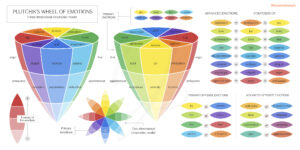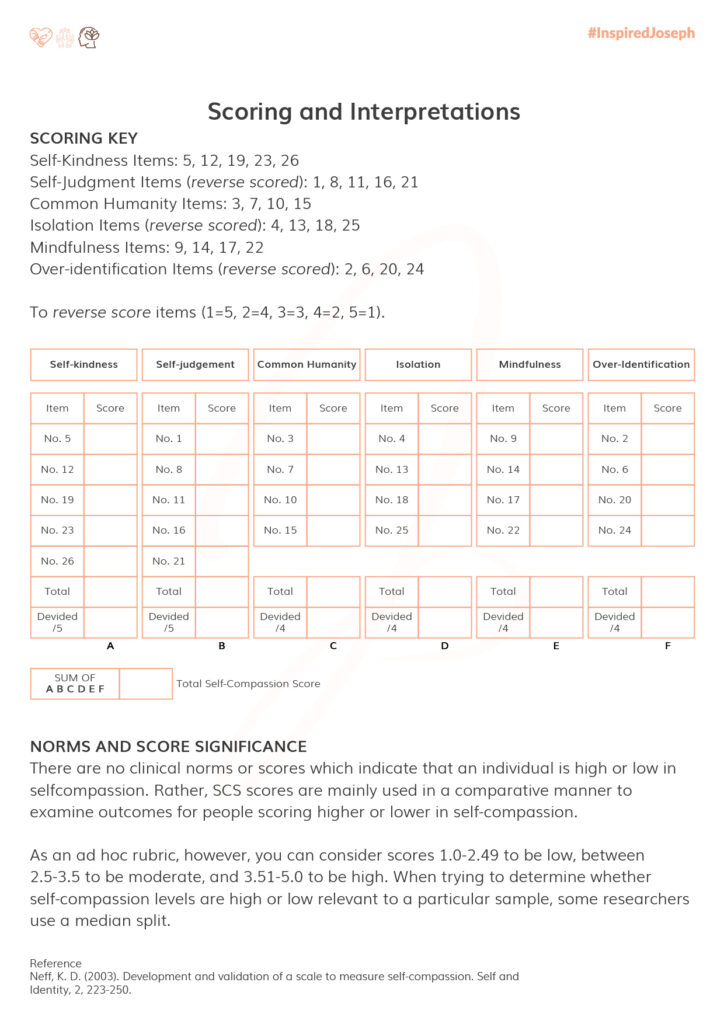The Self-Compassion Scale Assessment and Interpretations
Do you have self compassion?
Compassion
Our lives are full of uncertainty, whether we like it or not. Discomfort and negative feelings are collective life experiences. Through self-kindness, awareness, and the acceptance that adversity is integral to living, self-compassion provides a window of opportunity to investigate, identify, and ultimately heal one’s suffering.
When we develop an inner capacity for compassion, we care more about our well-being and try to lessen our pain. We learn to be less self-critical and treat ourselves compassionately when facing adverse events. The integration of compassion-based techniques within psychology and psychotherapy is developing rapidly. As the treatment value of self-compassion has grown, so does the need for reliability and validity of assessment/instruments.
In the subsequent article, we will look at how we may best measure self-compassion, the structure and validity of Kristin Neff’s Self-Compassion Scale, and the interpretation by which what can assess self-compassion.
The ability and practice of holding yourself amidst failure, disappointment, and suffering of any kind, and in the face of these life contractions, to still be able to offer myself love and kindness.
WHAT IS SELF-COMPASSION? Understanding Self-Compassion
Having self-compassion is showing understanding and kindness toward oneself. Many people have little trouble being kind to others, but they struggle to be empathetic to themselves. Being kind to oneself is not indicative of selfishness or pitiful thinking, but this may come off as self-indulgent to the untrained. Self-compassion has the potential to improve many aspects of mental health.
We may show self-compassion in actions like forgiving and caring for ourselves when things don’t go as planned. Compassion is the capacity to identify with and show concern for the suffering of another. Sadly, many sympathetic people have difficulty showing themselves the same compassion. They may be emotionally unhealthy because they refuse to own their mistakes for fear of indulging in self-pity or self-indulgence.
Three characteristics are necessary for self-compassion:
Self-kindness
0%
Acknowledging One's Humanity
0%
Mindfullness
0%

Self-compassion assessment To what extent can we measure self-compassion?
An essential part of helping your clients recover is testing and introducing them to self-compassion activities. When people learn to have compassion for themselves, they can better deal with adversity, forgive themselves and others, and progress. The foundation of self-compassion is found in accepting one’s inadequacies and the practice of increased self-kindness.
Is there a reliable way to evaluate self-compassion? While interest from counsellors and psychologists has increased, there is still some disagreement about whether compassion and self-compassion are distinct concepts.
This mystery has formed many compassion and self-compassion tests from various theoretical orientations in psychology. The most widely accepted definition of self-compassion has three essential components: kindness, common humanity, and mindfulness. Several tests contain all three components to varying degrees to clearly understand how self-compassion is exhibited in practice. Several assessments include all three of these factors to varying degrees.

Self-compassion assessment What is Self-Compassion Scale (SCS)
Please feel free to download our self-compassion scale and experiment with it before we go further into the assessment instrument. The Self-Compassion Scale was the first instrument of its type, created to measure individual variations in self-compassion. Three factors, including self-kindness, common humanity, and mindfulness, were first introduced to constitute the SCS.
However, it became clear during its development that the scale should include six aspects – the three fundamental components listed above, as well as its “negative” opposing constructions of self-judgment, isolation, and over-identification – representing compassionate vs uncompassionate conduct and a self-compassionate frame of mind.
The self-report 26-item questionnaire SCS precisely measures the thoughts, emotions, and behaviours that contribute to the three components of self-compassion and consists of measures that assess the frequency with which individuals react to feelings of inadequacy or suffering with each of the six elements.

The Six elements Self-Kindness vs. Self-Judgment
Instead of punishing ourselves with self-criticism when we experience hardship, setbacks, or feelings of inadequacy, self-compassion encourages us to be kind and compassionate toward ourselves. The matters we desire most aren’t always within our reach, and when this fact is rejected or battled, suffering rises in tension, frustration, and self-criticism.
Those who practise self-compassion accept the reality that they will make mistakes and fall short of their standards in life, and as a result, they are more patient with themselves when they encounter painful or upsetting events.

The Six elements Common Humanity vs. Isolation
A self-compassionate person acknowledges that we all face problems and failures, a natural component of the human condition. In this sense, self-compassion helps us recognize that pain is something we all experience, alleviating feelings of isolation.

The Six elements Mindfulness vs. Over-Identification
Mindfulness, the discipline of focusing one’s awareness on the here-and-now while also tolerating one’s inner experiences without judgement, is fundamental to cultivating self-compassion. We cannot dismiss our sorrow and have sympathy for it simultaneously. Self-compassion involves allowing unpleasant feelings to be experienced without judging them or beating oneself up over them.
Numerous research have utilised the Self-Compassion Scale to investigate the potential benefits of cultivating kindness and compassion toward oneself. A number of studies’ findings using the SCS point to the following benefits of self-compassion:
- Improves adolescents’ and adults’ self-reported emotional well-being.
- Self-judgment, feelings of loneliness, and over-identification are all reduced.
- Helps to explain how body dissatisfaction and negative social comparisons affect psychological quality of life.
- Can help reduce compassion fatigue and burnout in practitioners and caregivers.
- Significantly alleviates feelings of social anxiety, illogical thoughts, and guilt.
- Is related negatively with procrastination and maladaptive perfectionism.
- Results in increased motivation to make a positive difference, strive harder to learn, and avoid repeating previous mistakes, especially when it comes to health-related activities like maintaining to a diet, quitting smoking, or beginning a fitness programme.
The Self-Compassion Scale is available in 18 different languages for free: Japanese, Dutch, French, German, Greek, Chinese, Turkish, Portuguese, Brazilian Portuguese, Spanish, Italian, and Korean.

Self-compassion Assessment How the Scoring Works
SCORING KEY:
- Self-Kindness Items: 5, 12, 19, 23, 26
- Self-Judgment Items (reverse scored): 1, 8, 11, 16, 21
- Common Humanity Items: 3, 7, 10, 15
- Isolation Items (reverse scored): 4, 13, 18, 25
- Mindfulness Items: 9, 14, 17, 22
- Over-identification Items (reverse scored): 2, 6, 20, 24
To reverse score items (1=5, 2=4, 3=3, 4=2, 5=1)
Statements on the Self-Compassion Scale are assessed on a Likert scale ranging from 1 (almost never) to 5 (almost always).
To compute a total self-compassion score, first reverse score the negative subscale items – selfjudgment, isolation, and over-identification. Then take the mean of each subscale, and compute a total mean (the average of the six subscale means).
When examining subscale scores, higher scores on the self-judgment, isolation and over-identification scale indicate less self-compassion before reverse-coding, and more self-compassion after reverse coding. You can choose to report subscale scores with or without reverse-coding, but these three negative subscales must be reverse coded before calculating a total self-compassion score.

Self-compassion Assessment Interpretation
There are no clinical norms or measurements that indicate if a person has a high or low level of self-compassion. Rather, SCS scores are mostly used to compare outcomes for those who score greater or lower on self-compassion. As a rough guide on the 1-5 Likert scale:
- Average scores are around 3.0
- 1 – 2.5 = Low self-compassion
- 2.5 – 3.5 = Moderate
- 3.5 -5 .0 = High self-compassion
Scores from each subscale can predict a number of potential outcomes. For instance, a high score on the self-kindness subscale is a significant predictor of happiness while a low score is predictive of anxiety. Higher scores in the mindfulness subscale indicate greater life satisfaction while over-identification is an indicator of depression and isolation is a strong predictor for stress.
In essence, more self-compassionate actions are directly associated to enhanced positive mental states such as happiness and life satisfaction, while higher uncompassionate behaviours are directly related to negative mental states such as depression, anxiety, and stress.

Self-compassion assessment Scale Development and Validity
The SCS was developed in a sample of college undergraduates (Neff, 2003a). After identifying 71 items that were easily understood by students using a small pilot sample (n=68), exploratory factor analyses (EFA) were used with a larger sample (n=391) to identify 26 items that loaded best on separate subscales representing the six components of self-compassion.
Confirmatory factor analyses (CFA) were used to provide support that scale items fit as intended with the proposed a priori theoretical model. An initial CFA found a marginal fit to a higher-order model representing a global factor of self-compassion and six subscale factors. Cross validation using CFA in a second sample (N=232) found adequate fit for a higher-order model. Total SCS scores evidenced good internal reliability (Cronbach’s α =.92), as did the six subscales (Cronbach’s α ranging from .75 to .81).
Testretest reliability over a three-week interval was also good for the total score (Cronbach’s α =.93) and six subscale scores (with Cronbach’s α ranging from .80 to .88). More recently, bifactor Exploratory Structural Equation Modeling (ESEM) has been used to verify the factor structure of the SCS rather than a higher order model, as it is more theoretically appropriate. Neff et al. (2019) used bifactor ESEM to examine the factor structure of the SCS in 20 diverse samples (N = 11,685), and excellent fit was found for a model of one general factor of self-compassion and six specific subscale factors. Moreover, 95% of the reliable variance could be attributed to a general factor.
Although there has been debate over whether or not the SCS should be used as a total score or as separate positive and negative scores, empirical evidence tends to support the use of a total score rather than two separate scores (Neff, 2018; Neff, 2020). The factor structure of the SCS has also been found to be culturally invariant across 18 international samples (Tóth-Király & Neff, 2020).

Self-compassion assessment Pros and Cons of the assessment
Pros:
- The Self-Compassion Scale is an easy-to-use, administer, and score instrument. It has been translated into 18 languages and is free to use for academics, practitioners, students, and members of the general public.
- The SCS has been found to have internal consistency and test-retest reliability, as well as significant positive correlations with social connectedness, emotional intelligence, and life satisfaction, as well as significant negative correlations with self-criticism, perfectionism, depression, and anxiety.
- The SCS, as it is now written and assessed, is beneficial not just for enabling research, but also for clinicians attempting to teach their clients to be more self-compassionate.
- Several research using the SCS show strong predictive validity, with favourable associations between self-compassion and mental health indicators. High levels of self-compassion, for example, predict happiness, optimism, and life satisfaction, while low levels of self-compassion predict despair and anxiety.
Cons:
- Despite the scale’s widespread usage, some believe the lack of knowledge of how the SCS’s six components interact with one another to be problematic. A dditional comprehensive investigations are needed to determine if all of the characteristics contribute equally to a person’s compassion or whether one area may be more essential than another.
- Potential inconsistencies in the factor structures discovered by earlier studies suggest that the SCS structure might be potentially unstable and would benefit from more investigation. Neff herself indicated that the higher-order structure may not be the best way to understand compassion.
- The SCS may be better suited to measure the six components of self-compassion individually rather than the overall notion of self-compassion.
- Certain cultures have expressed reservations about the accuracy of the SCS translations. A recent research on self-compassion in Chinese Buddhists revealed that the six-factor model was unreplicable and that the Western concept of self-compassion is logically separate from Eastern views.
Self-Compassion & Self-Esteem
Self-compassion is often easily confused with self-esteem or linked to it, but the two are not the same: Self-compassion is a way to accept yourself, even when you fail. Self-esteem is more about giving yourself a positive review, especially for what you’ve done well. This feeling shows a shift from trying to be the best to just being who you are. A person who does well on self-compassion tests might be able to accept failures without getting defensive or making excuses. They might also be able to see that everyone, even themselves, deserves love and acceptance. On the other hand, having a high sense of self-esteem might make you ignore or hide your flaws.
A Message to Remember
In a culture that values self-assurance and confidence, we may forget one of the most fundamental qualities for living a better, more fulfilling life: self-compassion.
The desire for assessment tools to investigate and quantify self-compassion and other associated psychological processes is expected, given its many advantages and increasing therapeutic interest.
The strategies mentioned in this article for assessing self-compassion may give helpful information about customers, research subjects, and yourself.
Whether meant to evaluate self-compassion or other similar categories, the data gathered from such self-report surveys is often crucial and the first step toward recognising that we are all flawed individuals living in an imperfect world – and that’s OK.

Scanxiety – Phases, Symptoms, and Coping with it

Reaching new levels of relaxation using guided imagery – for stress and anxiety

The Emotion Wheel: Everything to know

Coping with lung cancer

Deeper insight into what cancer patients feel

